Historic Images of Sheffield City Centre

By Ian D. Rotherham & Christine Handley
Sheffield city centre developed from the old medieval town, with its nucleus being from the Parish Church of St Peter and St Paul, Barker’s Pool and Fargate through the market areas and down to the old castle. By the eighteenth century new commercial, residential and industrial areas were being set out, which began the town centre’s major expansion into the surrounding rural hinterland.
Queen Victoria Outside Sheffield Town Hall During the Official Opening in 1897
Taken from Pinstone Street during the official opening of Sheffield Town Hall in 1897, this view shows the elderly Queen Victoria in her carriage outside the main west entrance. The front of the building is still easily recognised apart from the awnings to protect the local dignitaries. (Reproduced by permission of Historic England Archive)
The Old County Court, Bank Street
Shown in 2001, the former county court building on Bank Street was opened in 1854. This was the forerunner of the county court building on the corner of Castlegate and is easily identifiable by the crest on the front of the building. This view also shows the side of the building and the steep lane down to West Bar, where the new court buildings are now situated. (© Historic England Archive)
The Old Town Hall, Castle Street
Built in three phases between 1807 and 1897, the building also accommodated the petty and quarter sessions courts. It replaced an earlier town hall, sited at the junction of Church Street, High Street and Fargate. It was enlarged in 1833, but because of lack of space the council moved to a new Town Hall, which was built in 1897. The Old Courthouse was the county court for Sheffield until 1997. (© Historic England Archive)
The Town Hall’s Grand Staircase
The interior of the Town Hall (the grand Victorian creation) is impressive. This view of the main staircase inside the Grade I-listed Town Hall was taken in 1897. It shows the ornate design made from grey and brown Devon marble with a balustrade of alabaster. The stairs lead to a superb extended balcony, off which are meeting rooms and reception rooms. (Reproduced by permission of Historic England Archive)
Pawson & Brailsford Buildings
Built in the late nineteenth century for the commercial printing business of Pawson & Brailsford, this building (seen here in 1897) was also known as Parade Chambers. The upper floors were occupied by solicitors and accountants, with Pawson & Brailsford’s shop on the ground floor. The gargoyles and other decoration echoed the parish church (later the cathedral), which it is next to. It includes a carved panel with the inscription ‘P&B 1883’. (Reproduced by permission of Historic England Archive
Cutlers’ Hall, Church Street
The classical-style building was opened in 1832 and a large banqueting hall was added in 1857. It is the third Cutlers’ Hall to stand on the site and was built by the Company of Cutlers in Hallamshire, which was founded in 1624 and grew to represent the business and commercial success of the town, and later the city. It is pictured in 2004.
Nos 210–214 West Street
The Cavendish Buildings, which occupy Nos 210–214 West Street, were built in 1910. The striking repeated design of different-coloured bricks, large windows and the distinctive roofline dominates this part of West Street. This general view from 2011 shows the corner of the building, which was built at an angle to the main street. (© Historic England Archive)
War Memorial Unveiling Ceremony, 1925
The war memorial in Barker’s Pool was unveiled by Lieutenant General Sir Charles Harrington, GOC Northern Command on 28 October 1925. Weighing 10 tons and approximately 35 metres long, the hollow steel mast was erected in August of the same year. Crowds of people are shown here as they witness the unveiling ceremony. (Reproduced by permission of Historic England Archive)
Fitzalan Square and City Centre
A view of Fitzalan Square and the statue of Edward VII. The central GPO building behind the statue is almost in the centre of this image. Taken in the early 1950s, this picture shows scaffolding marking the site of Walsh’s department store (middle right) being rebuilt after sustaining heavy damage during the Blitz in 1940. The building now sits on the corner of Arundel Gate and High Street, and still houses shops. The Marples Hotel, which sat on the cleared site to the right of Fitzalan Square, suffered a direct hit during the Blitz and seventy people lost their lives as a result. The large, pitched roofed building in the bottom left of the image was the Norfolk Market Hall, which was demolished in 1959 to make way for the new Cattle Market. The image also shows the earlier street pattern and many of the old buildings that were demolished in the 1960s to make way for a new modern cityscape with the short-lived ‘Hole in the Road’ and later Supertram. (© Historic England Archive. Aerofilms Collection)
The Triumphal Arch
Triumphal arches were temporary structures built as part of celebrations linked to royal visits. This example, on Lady’s Bridge, was erected in 1875 for the visit of the Prince of Wales (future Edward VII). Others were created at key points along major routes into or through the then town, along which the royal visitor would pass. (Reproduced by permission of Historic England Archive)
Peace Gardens, Pinstone Street
This area adjacent to the Town Hall was re-landscaped at the turn of the millennium. Originally known as St Paul’s Gardens after St Paul’s Church that stood alongside, it became known by Sheffielders as the ‘Peace Gardens’ because it was created at the same time as Chamberlain returned from Germany with the Peace Treaty. Today the more formal flower beds and rose gardens have given way to water features and wide paths. The gardens, shown here in 2004, are now a venue for street markets and festivals throughout the year. (© Historic England Archive)
Central Fire Station
This imposing building on Division Street, photographed in 1991, is now residential flats on the upper floors and a bar on the ground floor. Its frontage was built in the 1920s, extending the old Rockingham Street fire station and creating the new Central Fire Station, which opened in 1929. The large doors and area where the fire engines were housed are still evident, as is the name on the lintel above. (© Crown copyright. Historic England Archive)

 ‘Historic England: Sheffield’ is published by Amberley Publishing, £14.99 paperback, ISBN: 9781445683683
‘Historic England: Sheffield’ is published by Amberley Publishing, £14.99 paperback, ISBN: 9781445683683





















